Services
- Static Equipment & Structures (Piping Vibration & Fatigue)
- Acoustic Fatigue Assessment for Blowdown Systems
- Acoustic-Induced Vibration (AIV) Analysis
- Finite Element Analysis (FEA) and Computational Fluid Dynamics (CFD)
- Flow-Induced Turbulence (FIT) Analysis
- Flow-Induced Vibration (FIV) Analysis
- Multiphase and Slug Flow Analysis
- Pipe Stress Analysis
- Piping Vibration and Integrity Assessment
- Review & Design Support Services
- Small-Bore Connections (SBC) Assessment
- Structural Vibration and Dynamic Design Analysis
- Subsea Piping Vibration
- Thermal Striping
- Tube Failure Analysis
- Veridian AM
- Veridian VS
- Vibration Inspection Program
- Water Hammer Analysis
- Machinery Analysis
- Bottle Sizing Service
- Compressor Package Engineering
- Finite Element Analysis (FEA) and Computational Fluid Dynamics (CFD)
- Foundation Design and Dynamic Analysis
- Fuel Gas Compressor Piping Transient Analysis
- Lateral Vibration Analysis
- Pipe Stress Analysis
- Pulsation & Mechanical Analysis: Reciprocating Compressor
- Pulsation & Mechanical Analysis: Reciprocating Pump
- Pulsation & Mechanical Analysis: Screw Compressor
- Pump RCF Analysis
- Review & Design Support Services
- Shell Transverse Acoustical (STA) Analysis
- Skid Design and Analysis
- Surge Control Design for Centrifugal Compressor Systems
- Torsional Vibration Analysis (TVA)
- Field Engineering & Troubleshooting
- Finite Element Analysis (FEA) and Computational Fluid Dynamics (CFD)
- Human Vibration
- Motion Amplification Vibration Analysis
- Noise Troubleshooting
- Performance Assessment (Thermodynamic)
- PostPro – field data processing and analysis
- Structural Vibration Troubleshooting
- Thermal Striping
- Troubleshooting, Root Cause Analysis (RCA)
- Veridian iDAC
- Vibration Inspection Program
Small-Bore Connections (SBC) Assessment
for all machinery types and applications
_Vibration_Analysis_-_banner.jpg)
Small-bore connections, also called branch connections, to the main process piping represent the most common vibration problem on rotating and reciprocating machinery and associated process piping.
Small-bore connection design assessment and field vibration testing are strongly recommended to avoid piping integrity risks.
Contents [ hide ]
1 Background: Small-Bore Connections; Definition, Risks and Consequences
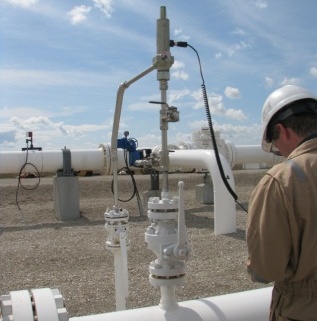 |
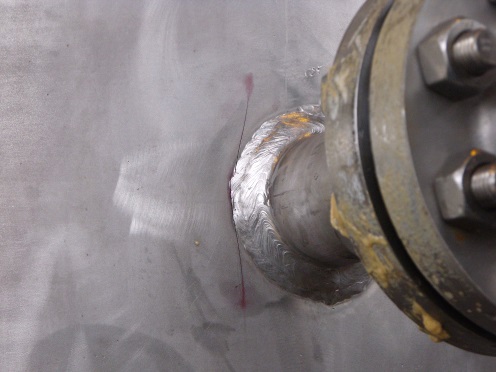 |
|
| Field audit of small-bore connections | Cracked vessel due to SBC (blind flange) | |
Piping vibration and fatigue can account for up to 20% of hydrocarbon releases; and a large portion of those are due to failure of small-bore connections per Energy Institute, 2008, Guidelines for the avoidance of vibration-induced fatigue failure, (AVIFF). Hydrocarbon emissions can lead to fire, explosions, injuries, property and environmental damage, and penalties.
A small-bore connection (SBC) is generally defined as a branched connection on mainline piping that has a nominal diameter 2” (DN 50) and smaller, including connections that have a branch pipe to mainline pipe ratio of less than 10%, and excluding connections that have a ratio of greater than 25% (see Figure below). Note that “mainline piping” could also describe equipment like a vessel or cooler to which the SBC is attached.
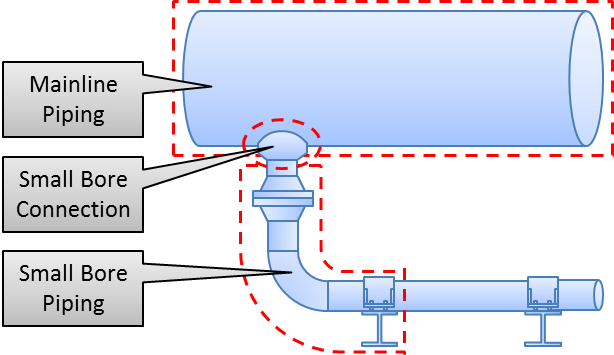 |
 |
Small-bore piping (SBP) is defined as the piping attached to the small-bore connection, extending until the effect of the mainline piping vibration is negligible (typically, the nearest support or brace), as shown in the illustration below.
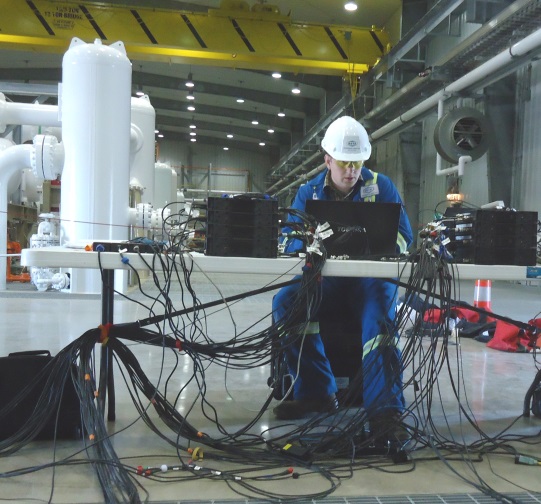 |
|
Multichannel systems used to assess SBC vibration risks |
SBCs are highly susceptible to problems due to their geometry and mass. Even very low amplitude (and acceptable) vibration on the main process piping can cause the branch connections to vibrate excessively and break due to fatigue failure. This is due to the local resonance of the SBC (see our Training video, Module 1 for examples of resonance). At certain frequencies, base vibration can be amplified by 20 to 30 times, causing branch connections to fail.
The consequences of a vibration-induced failure can be catastrophic. A small crack will release process fluids causing safety risks (explosion, fire, or toxic chemicals), environmental risk to the nearby area, and production downtime. In recent cases, SBC failures have been responsible for the shutdown of a pipeline and production facilities for weeks. Given the risk of these piping failures, owners must take an active role in avoiding them.
2 Approach and Scope
2.1 Approach
To address SBC integrity risks, the owner must specify the appropriate engineering assessment. Ideally, the evaluation occurs in three stages, as shown in the table below.
| SBC assessment activities | |
|---|---|
| FEED/planning Defines the appropriate scope and requirements for dynamic design |
Screening Assessment of Piping System: Pulsations, Flow Turbulence, Acoustic-Induced, Mechanical excitations, Surge, Other Transient Events |
| Detailed design Review and evaluate SBC designs |
SBC Analysis: Quantitative Approach, Identify Fatigue Risks, Finite Element (if required), Recommend Modifications |
| Commissioning/operations Onsite testing, documentation, modifications (steady state and transient flow evaluations) |
SBC Vibration Assessment (Baseline): Steady State Conditions, Transient Operations, Extrapolate Results to Other Operating Conditions |
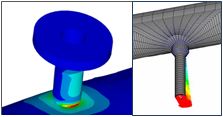 |
|
Finite Element Analysis (FEA) is used to calculate stress and confirm acceptance (or failure) of small-bore piping design |
Qualified dynamic engineering experts are required to perform this work because it involves stress analysis, fatigue failure analysis, FEA, and other advanced dynamic analyses.
Warning: One common misconception is that a SBC assessment is similar to a standard vibration monitoring program such as condition based monitoring or route bases vibration check, which is often performed by vibration technicians. While this program is useful for monitoring degradation in bearings, it is not applicable to SBC engineering design and evaluation.
The scope of the SBC assessment will vary based on the application (liquid, gas or multiphase), operating frequency, location, and process conditions. These variables will affect the type of analysis conducted at site.
2.2 Scope (Design and Field Analysis)
The following standard services are available for address SBC piping integrity risks. Contact Wood for more information on the detailed scope, or if a customized solution is required.
| New projects (or modified systems) - includes design and field activities | |||
|---|---|---|---|
| Service | Description | Summary | Remaining risks |
| SBC-D1 | Design SBC Review |
Basic approach: review available drawings and provide “best practice” recommendations. No field measurements. |
Medium Many remaining risks since resonance is possible (and no field verification/testing) |
|
SBC-D2 |
Standard SBC Integrity Assessment |
Design evaluation of proposed SBC with recommended changes. |
Low Common risks are significantly addressed. A small amount of residual risk remains. |
|
SBC-D3 |
Comprehensive SBC Integrity Assurance |
Wood is directly involved in SBC design to ensure a safe system that avoids resonances at key frequencies. |
Minimal Maximum assurance for the designed operating system. |
| Existing operations | |||
|---|---|---|---|
| Service | Description | Summary | Remaining Risks |
|
SBC-F1 |
Standard SBC Field Assessment |
Ideal for evaluating SBC integrity and the associated piping on the machine system. Includes impact testing for MNFs, vibration screening, speed sweep, and detailed FEA (if required) to resolve problem locations. |
Low For standard service, there are practical limits to testing all locations. Not all operating conditions checked. Plant piping (off-skid) SBCs not evaluated. |
|
SBC-F2 |
Comprehensive SBC Integrity Audit |
For critical applications where more stringent testing is required. Includes transient and steady state testing, fatigue analysis, and assessment of pipe strain. Can include station piping (away from the rotating/reciprocating machine). |
Minimal Common risks are significantly addressed. A small amount of residual risk remains. |
To mitigate this risk, the owner (or its Engineering Consultant) must specify a SBC vibration study.
3 Wood Advantages
- Over 50 years of field experience in SBC evaluations.
- Multichannel data acquisition system (>100 channels) for SBC testing – a key advantage for larger piping systems.
- Design experts in dynamics, pulsation control, vibration mitigation on reciprocating and rotating assets.
- R&D programs focused on developing innovative solutions to evaluate and mitigate SBC vibration, including research for the Gas Machinery Research Council (GMRC).
- Preferred supplier to the largest gas and liquid operators and pipeline companies.
- Global support, including field engineers certified for offshore facilities.
4 Related Information
- SBC Specification (to order the appropriate study)
- Primer - Piping Vibration INtegrity (PDF)
- Training Courses Wood ’s training seminars feature demos, live testing of SBCs, and mitigation strategies
- Guidelines for the avoidance of vibration-induced fatigue failure in process pipework (AVIFF)
Developed by the Energy Institute. Ask how we help customers apply this standard during the design and field operations, and can incorporate other recommended approaches. - Improving Equipment Reliability - Small-Bore Attachments (pdf)
- Small-Bore Piping Failures on the Rise, CompressorTech2, 2012 (pdf)
- Transient Conditions on SBP Discusses how transient operating conditions can affect vibration on SBP
- Vibration Related Failures of small-bore attachments (pdf)Technical Paper on SBP design principles
- INTEGRITY EVALUATION OF SMALL BORE CONNECTIONS (BRANCH CONNECTIONS) (PDF)European Forum of Reciprocating Compressors (EFRC), 2014
- Video: small-bore Piping Examples
- Video: Training Module 1 - Reciprocating Compressor - An Overview of Vibration Issues
Explanation of resonance and vibration equation, concepts that contributes to SPC vibration
5 Related Services
- PIPING VIBRATION AND INTEGRITY ASSESSMENT
- RECIPROCATING COMPRESSOR PULSATION AND MECHANICAL ANALYSIS
- RECIPROCATING PUMP PULSATION AND MECHANICAL ANALYSIS
6 Keywords
- Branch connections
- Small-bore connections (SBC)
- Small-bore piping
- Small-bore failure
- Small-bore fatigue
- Small-bore vibration
- Branch connection failure
More Info
Webinar: Shake, rattle and grow (2022 update) • Webinar: Vibration problem solving – back to basics • Webinar: Controlling dynamic flexibility • Webinar: Piping and tubing vibration anomaly mgmt • Multi-channel vibration measurements • Five simple methods to check reciprocating compressor performance • Webinar: Feeling the pulse • Vibration-induced fatigue management (Offshore Magazine) • Webinar: Shake, rattle and grow I (2022 update) • Avoiding vibration-induced fatigue failure • Design Requirements for Reciprocating Compressors • Examples of Piping Vibration (Video) • Evaluating Compressor Operating Risks • Pipe Support Stiffness, GMRC Project • Transient Conditions on Small-Bore Piping • Piping Vibration Design Considerations • Tips for Managing a Successful Vibration Project • Piping Vibration Examples • An Integrated Approach to Manage Vibration Risks •
Free webinar
Learn how to select and design vibration control solutions that work – using real-world data and case studies. Register now



